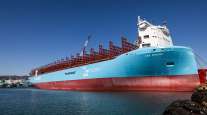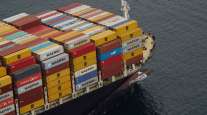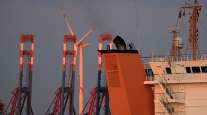Bloomberg News
Suez Canal Choked for Third Day as Elite Team Tackles Stuck Ship
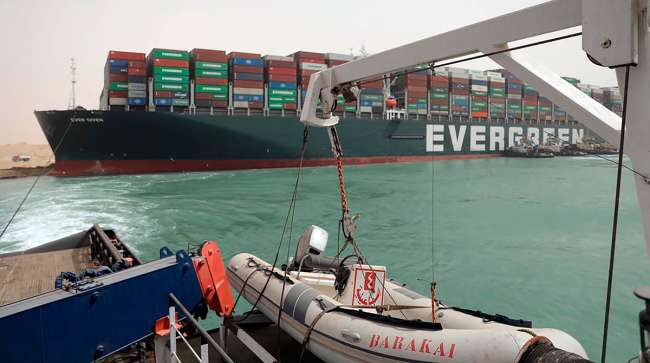
[Stay on top of transportation news: Get TTNews in your inbox.]
A huge backlog of ships was building up around the Suez Canal for a third day as an elite salvage team set about the monumental challenge of freeing the container vessel that’s blocking the crucial waterway.
Work to refloat the Ever Given and free up oceangoing carriers hauling almost $10 billion of oil and consumer goods continued without success March 25 in Egypt. Tugs and diggers have so far failed to budge the vessel, and some experts say the crisis could drag on for several days. The Suez Canal Authority has temporarily suspended traffic along the waterway.
At about a quarter-mile long and weighing 200,000 tons, the sheer size of the vessel is overwhelming efforts to dig it out.
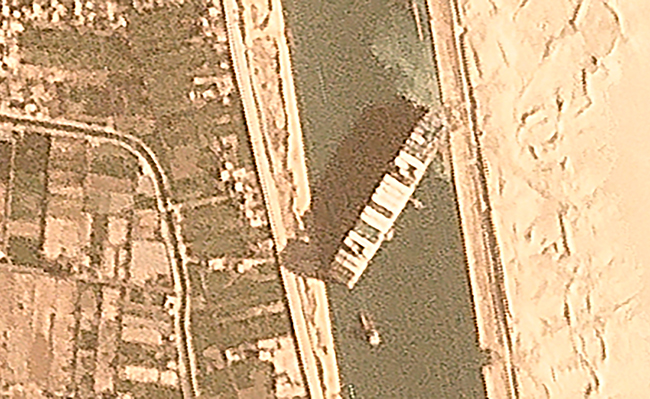
In this satellite image the MV Ever Given sits wedged in the Suez Canal on March 25. (Planet Labs Inc. via AP)
The front of the ship is wedged around 16 feet into the canal’s wall, which is one of the main obstacles to refloating it fully, according to a person familiar with the matter. Workers are dredging the bank to enable them to eventually tow the vessel away, the person said.
The salvors may have to lighten the ship by removing things such as the ballast water, which helps keep it steady while at sea. Fuel also could be unloaded.
About 12% of global trade goes through the canal, making it so strategic that world powers have fought over the waterway since it was completed in 1869. For now, all that traffic is backed up with the Ever Given aground in the southern part of the canal, creating another setback for global supply chains already strained by the e-commerce boom linked to the pandemic.
The struggle to dislodge the ship falls to SMIT Salvage BV, a Dutch firm whose employees fly from one shipping incident to the next, often boarding vessels during violent storms. Japan’s Nippon Salvage Co. has also been hired to assist in the refloating, according to people familiar with the matter.
Freeing the vessel “can take from days to weeks, depending on what we will be confronted with,” Peter Berdowski, CEO of SMIT’s parent company, Boskalis Westminster, said on the Nieuwsuur TV program in the Netherlands on March 24 “I can’t exclude that it can last weeks if the ship is really stuck and you need to get rid of cargo and you need to do dredging.”
“Dislodging a grounded ultra-large containership in the Suez Canal will be challenging due to the confined nature of the canal’s shipping channel,” said Rockford Weitz, director of the Fletcher Maritime Studies Program at Tufts University. “This presents additional complications in comparison to a grounding on a reef or shoal.”
The best chance for returning shipping to normal may not come until March 28-29, when the tide will reach a peak, according to Nick Sloane, the salvage master responsible for refloating the Costa Concordia, the cruise ship that capsized on the coast of Italy in 2012.
“Every hour, more vessels — including containerships, oil tankers, RoRo vessels and bulk carriers — are being backed up in the Mediterranean to the north and the Red Sea to the south,” said Jett McCandless, CEO of supply chain-tracking company project44 Inc. “It’s another big blow to global trade in an already backlogged and battered supply chain year.”
An estimate shows the blockage is snarling about $9.6 billion worth of traffic a day, based on calculations from Lloyd’s List that suggest westbound traffic is worth around $5.1 billion a day and eastbound traffic approximately $4.5 billion. On March 24, 185 vessels were waiting to cross the canal, according to shipping data compiled by Bloomberg, while Lloyd’s estimates there is 165.
About 34 container vessels chartered by Maersk Corp. and other shipping lines are either stuck in the canal or en route, according to project44. Preliminary reports show 10 crude tankers carrying a total of 13 million barrels could be affected by the disruption, according to Vortexa Senior Freight Analyst Arthur Richier.
The incident began March 23 when strong winds kicked up sands along the banks of the 120-mile canal. The waterway is narrow — less than 675 feet wide in some places — and can be difficult to navigate when there’s poor visibility.

Even before the pandemic, DHL's Larry S. Onge and Jim Monkmeyer set up strategies and implemented technology in order to respond to disruptions. Now, they know exactly how to get the vaccine from point A to point B — and, better, how to do it at a global scale. Hear a snippet, above, and get the full program by going to RoadSigns.TTNews.com.
But the Ever Given stayed its course through the canal, on its way to Rotterdam, Netherlands, from China. As gusts that reached as high as 46 mph swept up dust around it, the crew lost control of the ship and it careened sideways into a sandy embankment, blocking nearly the entirety of the channel. It’s still in the same position as when it ran aground, according to Inchcape.
At the heart of all of this is the ship’s massive scale. Container vessels have nearly doubled in size in the past decade as global trade expanded, making the job of moving such ships much harder when they get stuck.
Even while key routes, including the Suez Canal, have been widened and deepened over the years to accommodate the megasize vessels, the work to dig them out after they get stuck takes enormous power.
The canal is among the most trafficked waterways in the world, used by tankers shipping crude from the Middle East to Europe and North America, as well as in the opposite direction.
The blockage highlights a major risk faced by the shipping industry as more and more ships transit maritime chokepoints including the Suez, Panama Canal, the Strait of Hormuz and Malacca Strait. Such occurrences could become more common as ships get bigger and waterways become more congested.
Oil companies are starting to prepare for the worst. On March 24, there was an uptick in interest from oil companies looking to book tankers with options to avoid the canal, according to a broker, and several bid for space on the pipelines that allow bypass of the waterway completely.
For now, that’s a just-in-case move. Containerships most likely will have to wait it out, as the main alternative is the unattractive option of sailing around the southern tip of Africa. However, at least one shipment of liquefied natural gas from the U.S. has potentially diverted course toward the Cape of Good Hope and away from Suez, Wood Mackenzie analyst Lucas Schmitt said in a note March 25.
“We are now watching out for, and expect, vessel diversions,” ship broker Braemar said in a report. Large tankers carrying oil products from the Atlantic basin “are now likely to be evaluating a passage around the Cape of Good Hope” instead of heading for Suez, it said.
The disruption comes at a time when oil prices already are volatile. Crude surged above $70 a barrel earlier this month on Saudi production cuts, only to slump to near $60 this week due to setbacks in Europe’s coronavirus vaccine program.
— With assistance from Alex Longley, Julian Lee, Anthony Di Paola, Javier Blas, Sergio Chapa, Robert Tuttle, Aaron Clark, Mirette Magdy, Jack Wittels and Fred Pals.
Want more news? Listen to today's daily briefing below or go here for more info:


